#Stone Sculptures in Germany
Explore tagged Tumblr posts
Text
Stone Sculptures in Germany - Exploring Contemporary Zimbabwe Art
If you have a passion for art that transcends cultural boundaries, you're in for a treat. Welcome to KD Sculptures Gallery, your gateway to the captivating world of contemporary stone sculptures from Zimbabwe, now proudly represented in Germany. As a small, family-run business that has flourished over time, we are dedicated to promoting the most extraordinary and innovative works of art. Our gallery serves as a bridge that connects talented sculptors from Zimbabwe with art enthusiasts in Germany.
Unveiling Zimbabwe Sculptural Excellence
At KD Sculptures Gallery, we're not just about showcasing art; we're about sharing stories, traditions, and creativity that span continents. Our commitment to promoting Zimbabwe stone sculptures comes from a deep appreciation for the artistic heritage of Zimbabwe and a desire to help sculptors flourish in a global market. These sculptures are not mere objects; they are a testament to the rich cultural history of Zimbabwe and the ingenuity of its people.
A Fusion of Tradition and Modernity
Our collection is a testament to the versatility of stone as a medium for artistic expression. The sculptures on display embody the spirit of Zimbabwe while embracing contemporary themes and techniques. Every piece tells a story, reflecting the artist's perspective, emotions, and connection to their roots.
Empowering Zimbabwe Sculptors
KD Sculptures Gallery serves as a platform that empowers Zimbabwe sculptors to expand their horizons. By representing these artists in Germany, we provide them with an international platform to showcase their skills and gain recognition on a global scale. Our collaboration has not only encouraged the development of artistic techniques but has also fostered cultural exchange and understanding.

Click here :- Buy office sculptures/art online
A Journey Through Creativity
Walking through our gallery is like embarking on a journey through the vibrant landscapes of Zimbabwe. Each sculpture is a snapshot of the artist's imagination, chiseled into stone with dedication and precision. From intricate animal forms that capture the essence of the African wilderness to abstract pieces that evoke a myriad of emotions, our collection appeals to a diverse range of tastes.
Experience Zimbabwe Art in Germany
Our commitment to bridging cultures extends to the heart of Germany. Our gallery provides art enthusiasts, collectors, and the curious with an opportunity to experience Zimbabwe art without leaving the country. Whether you're an avid collector or a newcomer to the world of art, our sculptures have the power to inspire, captivate, and provoke thought.
Bringing Zimbabwe Culture Home
KD Sculptures Gallery isn't just a place to buy art; it's a space to bring a piece of Zimbabwe culture into your home. Each sculpture is an embodiment of the sculptor's dedication and skill, and having one in your living space means being part of their artistic journey. It's a connection that transcends borders and time, a testament to the universality of human expression.

Explore Our Collection
Visit our gallery to witness the convergence of Zimbabwe artistic heritage and modern creativity. Our collection showcases the evolution of stone sculptures, from traditional themes to contemporary narratives. With each piece, you're not just acquiring art; you're acquiring a piece of history, a slice of culture, and a glimpse into the soul of an artist.
Join Us on a Creative Voyage
KD Sculptures Gallery invites you to be part of a creative voyage that spans continents and cultures. As you explore our collection of Zimbabwe stone sculptures in Germany, you're contributing to the legacy of these talented artists. Our gallery is more than a space; it's a celebration of human imagination and the power of art to connect us all.
Discover Stone Sculptures in Germany Today
Ready to embark on a journey of artistic discovery? Visit KD Sculptures Gallery to witness the fusion of Zimbabwe creativity and German appreciation. Immerse yourself in a world where stone comes to life, where tradition meets innovation, and where Zimbabwe sculptures find a home in the heart of Germany.
Explore our collection and become a part of the artistic tapestry that unites cultures and transcends borders. Contact us at [email protected] to learn more or schedule a visit.
(FAQs)
What is KD Sculptures Gallery?
KD Sculptures Gallery is a family-run art gallery based in Germany that specializes in showcasing contemporary Zimbabwe stone sculptures. We bring a diverse collection of these exquisite sculptures to art enthusiasts, collectors, and anyone who appreciates the fusion of tradition and modernity in art.
Why Zimbabwe stone sculptures?
Zimbabwe has a rich tradition of stone sculpting that spans generations. These sculptures capture the essence of the country's cultural heritage while also embracing contemporary themes. We are dedicated to promoting and preserving this art form by representing talented Zimbabwe sculptors in Germany.
How do you select the sculptures for your collection?
Our team curates the collection by handpicking sculptures that demonstrate exceptional craftsmanship, creativity, and a unique narrative. We seek pieces that reflect both the artist's perspective and the cultural heritage of Zimbabwe, ensuring a diverse and captivating collection.
Can I purchase sculptures from your gallery?
Absolutely! All sculptures in our collection are available for purchase. You can explore our gallery online or visit our physical location to view and acquire the sculptures that resonate with you. We offer a seamless purchasing process to make owning these remarkable pieces easy.
Do you offer international shipping?
Yes, we provide international shipping for our sculptures. Whether you're in Germany or anywhere else around the world, we'll ensure that your chosen sculpture reaches you safely and securely, allowing you to enjoy the beauty of Zimbabwe art from the comfort of your own space.
Can I visit your gallery in person?
Yes, we welcome visitors to our physical gallery location. If you're in Germany or planning to visit, we encourage you to schedule a visit to immerse yourself in the world of Zimbabwe stone sculptures. Please contact us to arrange a suitable time for your visit.
Are the sculptures suitable for both indoor and outdoor spaces?
While some sculptures are suitable for both indoor and outdoor display, it's recommended to consult with our team before placing a sculpture in an outdoor setting. Different types of stone and finishes may affect the sculpture's durability in varying environments.
How do I care for and maintain the sculptures?
Zimbabwe stone sculptures are durable, but they benefit from proper care. Keep them away from direct sunlight, extreme temperatures, and harsh weather conditions. To clean, use a soft cloth or brush to remove dust, and avoid using abrasive or chemical cleaners.
Can I commission a custom sculpture?
We are open to discussing custom sculpture commissions. If you have a specific idea or concept in mind, please reach out to us with your requirements, and we'll work closely with our artists to bring your vision to life.
How do I get in touch with KD Sculptures Gallery?
You can contact us through our website's contact form or by emailing us at [[email protected]]. We're here to answer any questions you may have and assist you with all your inquiries.
Do you host art events or exhibitions?
Yes, we periodically host art events and exhibitions to celebrate the work of our featured sculptors and engage with art enthusiasts. Follow our website and social media channels to stay updated on upcoming events and exhibitions.
How do you support Zimbabwe sculptors?
We are committed to supporting Zimbabwe sculptors by providing them with an international platform to showcase their talent. By representing them in Germany, we enable them to reach a wider audience and connect with art enthusiasts who appreciate their craftsmanship.
Source:- https://kdsculpturesgallery.blogspot.com/2023/08/stone-sculptures-in-germany-exploring.html
#Stone Sculptures in Germany#Stone#Sculptures in Germany#Buy sculptures and curios online#Outdoor sculpture suppliers in Germany#Repair & restoration sculpture services near me#Buy Shona sculptures online#Shona sculpture in Germany#Buy office sculptures/art online#Indoor sculptures/art#Stone Sculptures Gallery in Germany
0 notes
Text
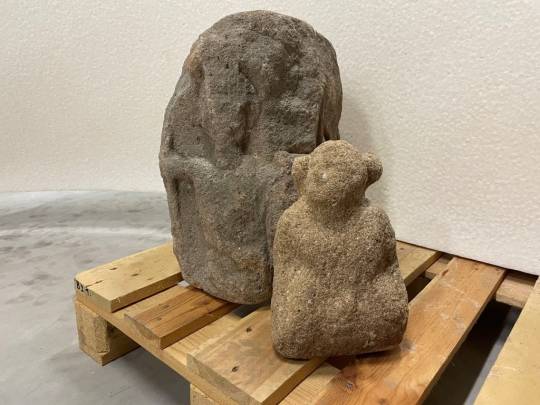
Stone Sculpture of a Roman ‘Giant’ Unearthed at Ancient Fort in Germany
The new find completes another artifact unearthed more than a century ago.
Due diligence in Stuttgart recently unearthed a stone sculpture that was actually part of an ancient Roman monument discovered at the same site more than a century ago. For the past few months, the State Office for Monument Preservation (LAD) has overseen excavations at a plot that had been tapped for the expansion of a local school. From 100 to 150 C.E., this very location hosted an ancient Roman fort, which became a larger settlement 100 years later. Those preliminary excavations paused, a release said, when an employee from the contractor ArchaeoBW spotted “a rather inconspicuous, mud-smeared sandstone.”
“The find turned out to be a 30 centimeter-tall kneeling figure with a human head,” the release says. “You can see how her arms rest on the sides of her upper body and her hands rest on her hips and legs.” It may take some imagination to fully grasp, but the chimera’s lower half shifts from a human torso to a serpent’s tail.
Fortunately, experts have ample historical context to understand the find. “The figure is a hybrid creature of the Roman-Germanic world of gods, a so-called ‘giant,’” said senior LAD archaeologist Andrea Thiel. Comparative analyses found that this figure hails from a larger Jupiter column—a type of religious monument that was particularly prevalent throughout Roman Germania during the 2nd and 3rd centuries.
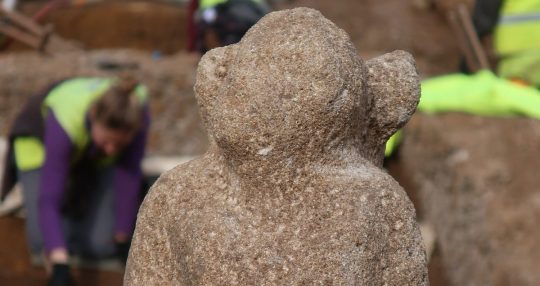
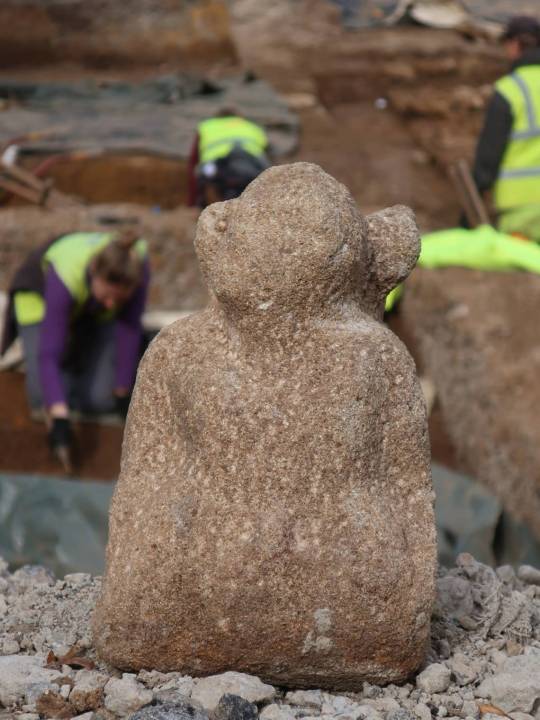
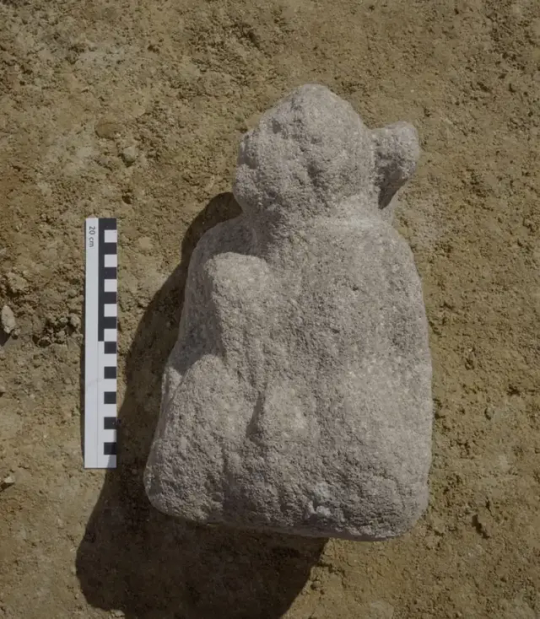
Jupiter columns “combine classical antiquity with probably Germanic beliefs,” Thiel explained. “Jupiter, throwing lightning bolts, rides on his horse over a figure crouching on the ground, usually naked and bearded, as can be seen, for example, in a group from Hausen an der Zaber in the Heilbronn district.” This specific example presented Jupiter as nature’s master, Thiel added.
“Every archaeologist is happy when a beautiful find is made,” he said. But, when the staff at the nearby Württemberg State Museum caught wind of the discovery, they remembered that most Jupiter columns included a Four Gods Stone at their base. “In the depot of the Württemberg State Museum there is a badly damaged Four Gods Stone with depictions of the Roman deities Mercury, Juno, Hercules and Minerva,” said the museum’s head of archaeology, Astrid Fendt. Mercury, Juno, and Minerva formed the Capitoline Triad of Gods. Although Juno wasn’t a fan of Hercules, the Hapsburg family did consider him a legitimate ancestor.
The museum’s Four Gods Stone surfaced in 1908 near a well on the edge of the same lot being excavated. “At the time, a large barracks was being built,” representatives for the city said. The find instigated a more exhaustive excavation. Thiel said that the figure they just found “could also have been lying there, but it probably escaped our colleagues at the time, which is not surprising.”
Crews will continue scouring the site for further artifacts through the end of May. “By then, the entire construction window will have been examined and all finds will have been recovered,” the city said. “We hope that it will soon be possible to show the little giant together with the relief of the gods in a special exhibition.”
By Vittoria Benzine.
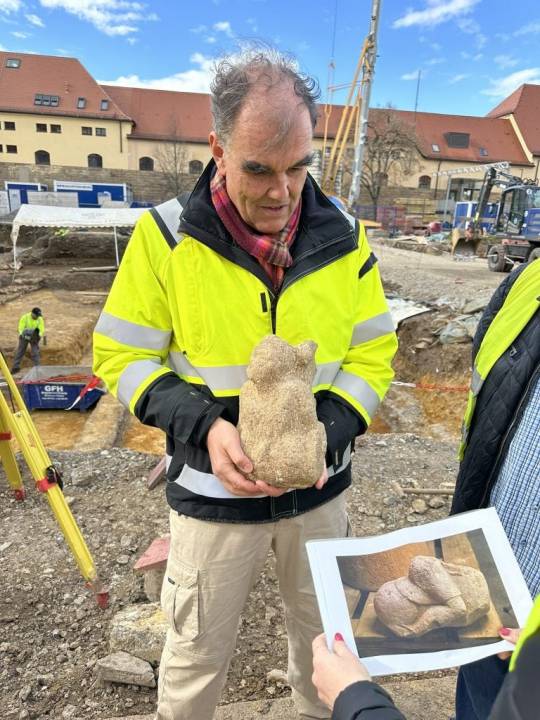
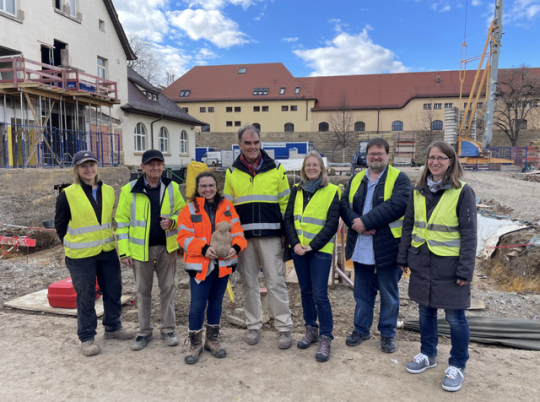
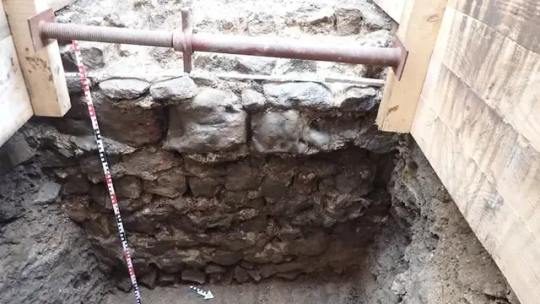
#Stone Sculpture of a Roman ‘Giant’ Unearthed at Ancient Fort in Germany#Stuttgart Germany#stone statue#ancient artifacts#archeology#archeolgst#history#history news#ancient history#ancient culture#ancient civilizations#roman history#roman empire#roman art
24 notes
·
View notes
Text


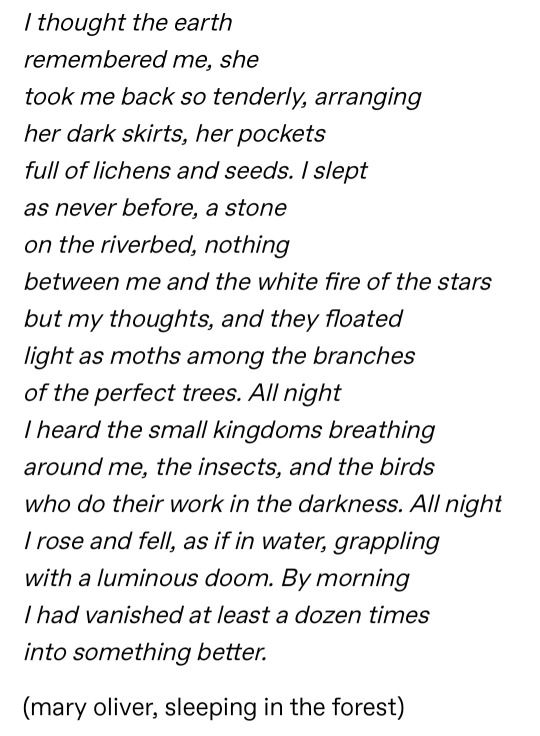
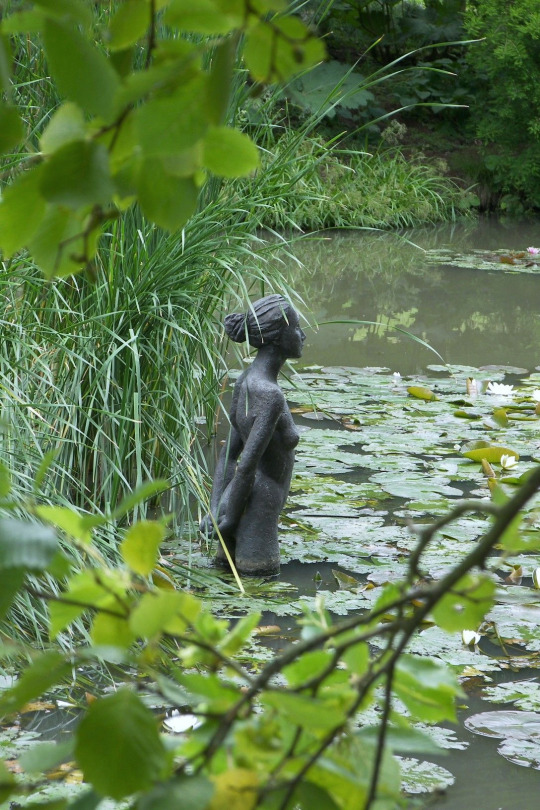





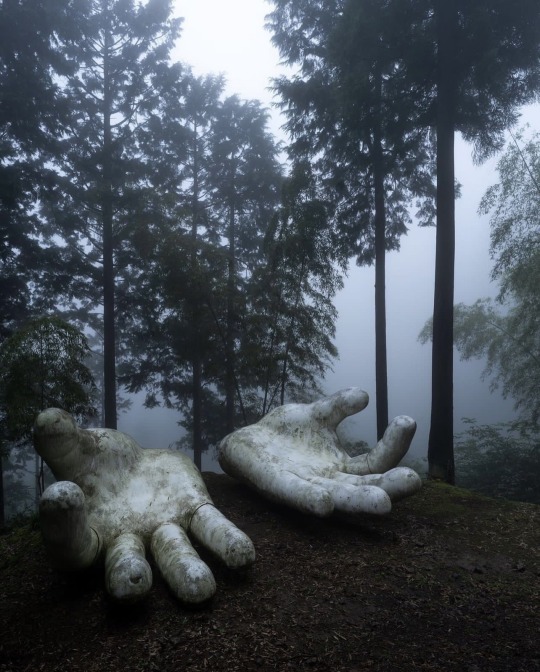
Credits:
Trees may have a ‘heartbeat’ that is so slow we never noticed it by Andy Coghlan / The Spirit of the Medieval Hunter, Anna & the Willow, Willow Sculpture (2018) / Mary Oliver, Sleeping in the Forest / Lady In The Water at Sir Harold Hillier Gardens (2008) / Quote fragment from Knut Hamsun / 'Thrive' by Daniel Popper (2020) / Quote fragment from Tales From Earthsea by Ursula K. Le Guin / Nesting in the crown of Mary at St. Ottilien Archabbey, Oberbayern, Germany / Quote fragment from 'The World Keeps Ending, and the World Goes On' by Franny Choi / Abandoned Stone Hands Sculpture, Japan
#artemis#artemis deity#artemis goddess#artemis worship#artemis devotee#artemis devotion#quotes#nature#nature quotes#nature photography#animism#helpol#hellenic polytheist#hellenic paganism#diana#diana deity#diana worship#diana devotee#diana devotion#e offering
317 notes
·
View notes
Text

Discovered in Russia in 1890, the Shigir Idol is one of the oldest known wooden sculptures, dating to approximately 12,000 years ago. It was found in a peat bog, which had preserved it.
The sculpture is 2.8 metres high, but its original height is thought to have been 5 metres or more. It was carved from a larch tree (approximately 159 years old at the time) using the jaws of a beaver and stone tools. On it are faces, hands, and zigzag lines.
It was apparently placed upright next to a lake before it fell into the bog, thus preserving it for over 12,000 years.
According to Thomas Terberger, a scholar of prehistory at Göttingen University in Germany:
“The idol was carved during an era of great climate change, when early forests were spreading across a warmer late glacial to postglacial Eurasia. The landscape changed, and the art—figurative designs and naturalistic animals painted in caves and carved in rock—did, too, perhaps as a way to help people come to grips with the challenging environments they encountered.”
It is currently on display in the Sverdlovsk Regional Museum of Local Lore in Russia.
. . .
Picture Credits: Siberian Times
#siberia#meanwhile in russia#paleolithic#archaeology#shigir idol#holy ground#shamanism#younger dryas
143 notes
·
View notes
Text


reconstruction of Archaeopteryx
Archaeopteryx fossil - Berlin specimen
Paleontologists have long thought that Archaeopteryx ('ancient feather' or 'ancient wing') fossils placed the dinosaur at the base of the bird evolutionary tree. Recent evidence suggests the beast may be best described as a birdlike dinosaur rather than an early bird, though it probably could fly after a fashion. Archaeopteryx is about 150 million years of age, while the ancestor of all living birds lived sometime in the Late Cretaceous — 50 to 65 million years ago.
In 1861, the first Archaeopteryx skeleton, which was missing most of its head and neck, was unearthed near Langenaltheim, Germany. However, the most complete skeleton, the Berlin Specimen, was discovered in 1874 or 1875 near Eichstatt, Germany by farmer Jakob Niemeyer, who sold it in 1876 to innkeeper Johann Dörr. Through various transactions, the fossil, which is the first found to have an intact head, eventually wound up being in the Humboldt Museum fur Naturkunde, where it still resides. To date there have been 11 other Archaeopteryx fossils found, the latest discovered in 2010 (described in 2014). All of the fossils come from the limestone deposits near Solnhofen. Recent tests performed on the specimens indicate that the primary coloring of the feathers of Archaeopteryx were black, possibly with lighter colored tips.
Jurassic deposits of Solnhofen limestone in southern Germany are marked by rare but exceptionally well preserved fossils of many species. It was first quarried nearly 2,000 years ago by the Romans who used the stone for paving roads and building walls. In later Roman times the mosaic floor of the church of Hagia Sofia in Istanbul was made of this limestone. In the Middle Ages, the stone was also used as floor and roofing material, and artisans used the material in the making of bas-relief sculptures and headstones. A decisive turning point in the history of the stone was the determination in 1673 by Alois Senefelder that the dense, fine-grained material was ideally-suited for use in the newly discovered printing process of lithography, a use that caused quarrying to increase dramatically.
20 notes
·
View notes
Text

Rickson Zavare 'Murehwa'
Rickson Zavare 'Murehwa', (b 1977) from Murehwa in Zimbabwe; is trained by his brother-in-law Tago Tazvitya and has been working with stone since 1996. He has helped build the Chitungwiza Arts Center, one of the largest arts collectives in Zimbabwe.
Rickson is inspired by the shape of the raw stone, events, joy, love, meditation and water.
Rickson's work with stone is about creating original sculptures, preserving African cultural heritage, cultural exchange and educating students and building self-confidence for the less privileged.
Rickson does exhibitions and workshops in Zimbabwe and in Germany, France, Holland, Canada, South Africa, USA, Korea and Australia.
2 notes
·
View notes
Text

“The Flameless Green Dragon”, 2018, Elm and acrylic

“In Rhythm”, 2018, Elm and acrylic; and “Water Music”, 2002, Inkjet photocollage on paper

“Introvert”, 2019, Elm; “Engendering Life”, 2020, Green soapstone

Two left sculptures made of Italian translucent alabaster and “Harboring Emptiness”, 2021, Maple and acrylic
Above are several works from Barbara Stanczak Spirit and Matter, the artist’s recent exhibition at Akron Art Museum. Stanczak’s sculptures are energetic shapes created in partnership with the natural materials used.
From the museum’s web page-
Barbara Stanczak’s sculptures are born from an essential combination: the artist’s creative vision and the natural qualities of her materials. This two-sided collaboration remains in effect throughout Stanczak’s entire process of conceiving and creating an artwork. A piece of wood or stone presents initial possibilities that help to set a direction, but invariably the course will change—the substance may be so hard as to resist carving, or it may contain internal structures that must be accommodated. But the artist does not surrender her own interests, as she has found that a successful work must become the physical embodiment of a rich and valuable idea. In her own words, “I can only hold onto my idea of the whole by letting go of ‘mine’ and focusing on ‘our.’ The material becomes a partner who needs my patience, respect, thoughtfulness, cooperation, skill, and persistence.”
Stanczak committed to working with wood and stone only after a long process of discovery. Born in Germany in 1941, she moved to the United States in 1960 to assist her grandfather in painting church frescoes, and later worked in handmade paper, metal, and a variety of other media. She also worked alongside her husband, Julian Stanczak, whose paintings and prints were celebrated at the Akron Art Museum with a one-artist show in 2013. As her own career evolved throughout her thirty-seven-year tenure as a professor at the Cleveland Institute of Art, Barbara carved her first wooden sculpture in 1992. “I was tired of searching,” she recalls. “It was time to arrive!”
Stanczak continues to find wood and stone compelling because, as she puts it, they are constantly “teasing, tempting, and provoking me to see more, to see beyond, to see the micro and the macro of the universe.” She finds these universal qualities not in immediately recognizable forms like leaves and flowers, but rather in dense rings and layers, subtle features formed over decades or even thousands of years. As Stanczak exercises her own intuition, she aligns it with these natural processes. As the artist and the materials harmonize, it is as if two forms of intelligence are working together—as if spirit and matter are not so separate as one might expect.
#Barbara Stanczak#Akron Art Museum#Akron Art Shows#Art#Art Shows#Sculpture#Mixed Media#Mixed Media Art#Ohio Art Shows#Ohio Artist#Photography#Wood Sculpture#Julian Stanczak#Year of the Dragon#Dragon
3 notes
·
View notes
Text

Discovered in Russia in 1890, the Shigir Idol is one of the oldest known wooden sculptures, dating to approximately 12,000 years ago. It was found in a peat bog, which had preserved it.
The sculpture is 2.8 metres high, but its original height is thought to have been 5 metres or more. It was carved from a larch tree (approximately 159 years old at the time) using the jaw of a beaver and stone tools. On it are faces, hands, and zigzag lines. No one knows what it was used for, but some say it could have been a territorial or navigational marker, or perhaps it depicts forest spirits or had some ritual purpose. Some have suggested that it depicts a creation myth.
The sculpture might have been placed upright next to an ancient lake before it fell into the bog, thus preserving it for over 12,000 years.
According to Thomas Terberger, a scholar of prehistory at Göttingen University in Germany:
“The idol was carved during an era of great climate change, when early forests were spreading across a warmer late glacial to postglacial Eurasia. The landscape changed, and the art—figurative designs and naturalistic animals painted in caves and carved in rock—did, too, perhaps as a way to help people come to grips with the challenging environments they encountered.”
This sculpture was carved about ten thousand years before the city of London was founded and is over twice the age of Stonehenge. A truly ancient artifact.
It is currently on display in the Sverdlovsk Regional Museum of Local Lore in Russia.
Picture Credits: Siberian Times
5 notes
·
View notes
Text
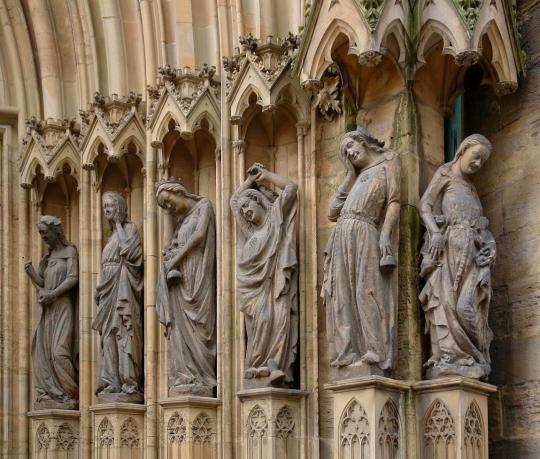
MWW Artwork of the Day (9/13/23) Late Medieval Germany (14th-15th c.) Detail: Parable of the Ten Virgins (15th c.) Stone sculptures Erfurter Dom, Erfurt (Germany)
The "Parable of the Ten Virgins," also known as the "Parable of the Wise and Foolish Virgins," was one of the most popular parables in the Middle Ages, with enormous influence on Gothic art, sculpture and the architecture of German and French cathedrals. The parable appears in only one of the Canonical gospels of the New Testament. According to the Gospel of Matthew 25:1-13, the five virgins who are prepared for the bridegroom's arrival are rewarded, while the five who are not prepared are disowned. The parable has a clear eschatological theme: be prepared for the Day of Judgment.
6 notes
·
View notes
Text
Heidelberg Castle
















Heidelberg Castle is located in Heidelberg, Germany. The Renaissance castle was built on a hilltop before 1214 for defense. The castle became a combination of many buildings from different periods built around a central courtyard. The 17th century gardens were built upon several terraces with mazes, arbors, sculptures, a greenhouse, fish ponds, and waterfalls, but now the garden beds are filled with trees. Prince Elector Ruprecht III of the Wittelsbach dynasty used the castle as his royal residence from 1398 to 1410. The castle continued to serve as a regal residence for the Prince Electors for 300 years. In 1537, a lightning strike caused a fire, destroying the upper castle. The castle suffered through fires in 1689 and 1693 due to wars with the French. In 1764, another lightning strike caused a fire that destroyed some of the rebuilt sections, leaving the structure destroyed and inhabitable. The castle stones were quarried and used to build houses for the citizens of Heidelberg. Heidelberg Castle is a ruin and serves as a landmark and tourist site. The world’s largest wine barrel was built in 1751 by Prince Elector Karl Theodor to house the wine paid as taxes. The wine barrel can hold 58,124 gallons of wine. There’s also a dance floor on top of it. On the lower level of the castle is an Apothecary Museum. A light show and firework display can be seen three times a year during the summer months, in memory of the last three times the castle went up in flames.
#castles#Heidelberg Castle#Germany#Heidelberg#apothecary museum#fireworks#world's largest wine barrel#venue#ruin
2 notes
·
View notes
Photo
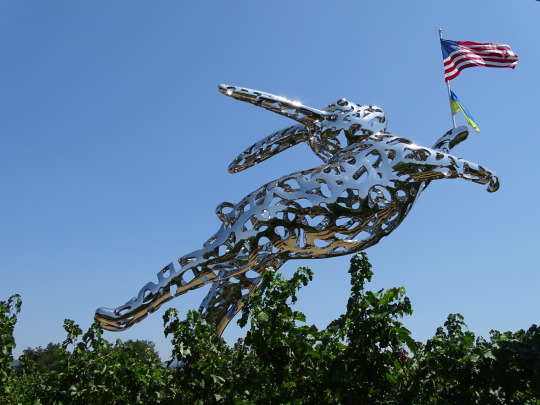
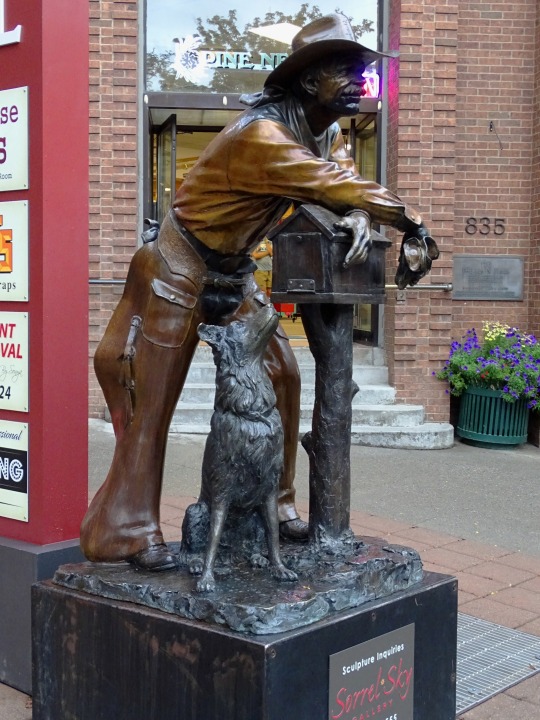



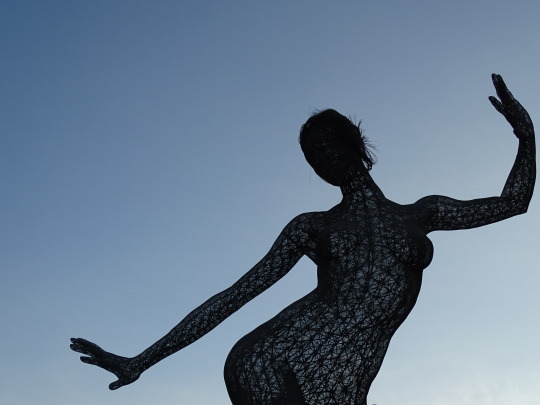


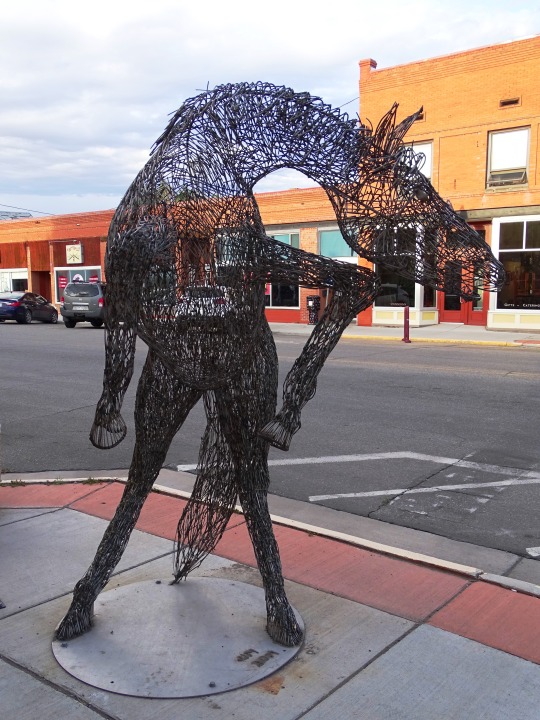
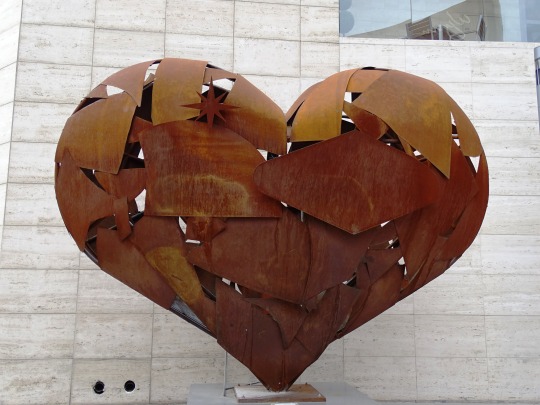
International Sculpture Day
International Sculpture Day is observed on the last Saturday of April every year and this year, it falls on April 29. It is an internationally recognized holiday that commemorates the art of sculpture and sculpted works. Sculptures are a type of visual art that is three-dimensional. Stone sculptures have been proven to last significantly longer than other works of art made of perishable materials, and they account for the vast bulk of all surviving non-pottery art from ancient cultures to this day. Sculptures have always been a major component of religious devotion in many cultures, and enormous sculptures were commonly used to represent religion or politics until recently. The ancient Mediterranean, India, and China, as well as various cultures in Central and South America and Africa, have the most surviving sculptures.
History of International Sculpture Day
The first undisputed sculpture pieces came from the Aurignacian culture in Europe and southwest Asia, which was active at the start of the Upper Paleolithic period. This culture developed well-crafted stone tools, pendants, ivory beads, and other forms of art. They are also attributed to being the first to create cave art and three-dimensional figures.
The Löwenmensch, found in Germany’s Hohenstein-Stadel area, is an anthropomorphic figure carved from mammoth ivory. It is believed to be one of the oldest known uncontested examples of figurative art, standing at 0.9 inches tall. Most prehistoric art that has survived to this day is movable sculptures found throughout central Europe.
The Swimming Reindeer from around 13,000 years ago is one of the greatest Upper Paleolithic Magdalenian bone carvings, however, it is outnumbered by engraved pieces, which are sometimes considered sculptures. The Tuc d’Audoubert caves in France, where a talented sculptor used a spatula-like stone tool and his fingers to build a pair of large bison against a limestone rock tens of thousands of years ago, are home to two of the world’s largest prehistoric sculptures.
Much of the figurative sculpture in Europe at the beginning of the Mesolithic era has been greatly reduced. These sculptures have remained less of a common element in art other than relief decoration of practical objects until the Roman period, despite works such as the Gundestrup cauldron from the European Iron Age and the Bronze Age Trundholm sun chariot.
The Mesopotamian conquest, as well as much of its surrounding territory by the Assyrians, created a larger and wealthier state than was previously usual in the region, with particularly grandiose art in palaces and public places, clearly an attempt to match the glory of the Egyptian empire art. The Assyrians created their sculptures in great numbers using easily carved stones from Northern Iraq.
International Sculpture Day timeline
800—721 B.C The Assyrian Lamassu is Created
The Assyrian gate guardian sculpture, Lamassu, is created.
1513—1515 Michelangelo’s Moses Sculpture is Created
Michelangelo creates the sculpture of Moses sometime during these years.
1793 Crucifixion of Jesus Christ Sculpture is Created
The Spanish sculpture of the Crucifixion of Jesus Christ is made from wood and polychrome.
1998 Angel of the North Sculpture is Created
Sculptor Antony Gormley creates the sculpture of the Angel of the North.
International Sculpture Day FAQs
Which country is famous for sculpture?
The Western sculpture tradition originated in ancient Greece, and the country is well-known for producing great masterpieces during the classical period. During the Middle Ages, Gothic sculpture expressed the Christian faith’s agonies and emotions.
Does the date for International Sculpture Day change?
Yes. The date for International Sculpture Day is the last Saturday of April every year.
Where did sculptures originate?
The earliest sculpture samples belonged to the Aurignacian culture, which was in Europe and southwest Asia and was active at the beginning of the Upper Paleolithic period.
International Sculpture Day Activities
Visit a museum of sculptures
Make your own sculpture
Share on social media
International Sculpture Day is an excellent reason to visit any of the many sculpture museums and historical sites that feature beautiful sculptures. This is also a chance to learn more about the history of sculptures and their sculptors.
You can seize this opportunity and spark your creativity by building your very own sculpture using available and sustainable materials. You can create something meaningful that you can put on display in your home.
Use the hashtag #InternationalSculptureDay to share all of your activities for International Sculpture Day on social media! Take as many pictures as you can and tag your friends!
5 Interesting Facts About Sculptures
Sculpture is three-dimensional
There are various materials for sculpting
Sculptures have cultural and religious origins
There are two major types of sculptures
Stone sculptures are the most durable
A sculpture is a three-dimensional visual art, which makes it all the more “realistic.”
Unlike in the past, when sculpting materials were only limited to stone, bronze, and a few others, modernism has changed the order of things and a variety of materials can be used for sculptures.
Most prehistoric sculptures were born out of a reference to cultural, religious, and political themes.
There are two major types of sculptures which are “statues” and “relief” sculptures.
Most of the prehistoric sculptures and other art forms are stone sculptures.
Why We Love International Sculpture Day
Sculptures tell us stories
Art relaxes the mind
It is food for the soul
Most sculpture works have a story to them; either of religious, cultural, or political origin. International Sculpture Day allows us to learn about the history of sculptures and the artists who created them.
Creating art relaxes the mind. It allows people to showcase their passion by doing something they love.
Ever seen a sculpture or other work of art and felt so… filled? Exactly. Viewing beautiful art pieces is like food for the soul.
Source
#Waiting on an Answer by George Lundeen#Bad Decision by Vic Payne#USA#Bunny Foo Foo by Lawrence Argent#Big Bill Murphy by Adam Skiles#Bliss Dance by Marco Cochrane#Satos Horse by Jim Johnson#Heartfullness Vegas by Katy Boynton#Trouvaille by Kasia Polkowska#Beliers by François-Xavier Lalanne#International Sculpture Day#29 April 2023#last Saturday in April#summer 2022#original photography#public art#travel#vacation
3 notes
·
View notes
Text
#Stone Sculptures Gallery in Germany#Indoor sculptures/art#Shona sculpture in Germany#Buy Shona sculptures online#Repair & restoration sculpture services cost#Repair & restoration sculpture services near me#Outdoor sculpture suppliers in Germany#Best Sculpture artist company in Germany
1 note
·
View note
Text

Marble Lion’s Head Sculpture Discovered in Sicily
Archaeologists have uncovered an unusually large marble lion gargoyle belonging to one of Sicily's ancient Greek temples.
Only nine other ancient Greek temples in southern Italy and Sicily are known to have marble gargoyles like this, which would have been imported from the Greek islands in the 5th century BC.
The Ruhr University in Bucham, Germany, which led the study, said that marble like this was "rare and valuable" at the time when this stone lion was built, suggesting that it would have been made for a temple of great significance.
"We cannot yet say whether it was intended for the well-known Temple E in Selinunte or for another, as yet unknown temple," archaeologist Jon Albers, from the Ruhr University, said in a press release.
Stone figures like this are known as "simas." They form the upturned edge of the temple roof which acts as a sort of gutter to collect rainwater, like an ancient precursor to the gargoyles of Gothic architecture. Simas were often decorated, and lion's heads were a common feature, as well as rams, dogs and other animals.
In most cases, simas were made of terracotta or limestone. But this new find is made of 24 inches of marble.
The "Temple E" Albers referenced also contains a frieze made from this valuable stone. Its construction dates back to between 490 and 450 BC and was built in honor of the Greek goddess Hera, according to the University of Michigan Library.
In Greek mythology, Hera is the wife of the king of the gods, Zeus, and is the goddess of women, marriage and childbirth.
But, according to Albers, there may have been an additional, unknown temple to which this stone gargoyle belonged. Lions were traditionally used on temples to act as "guardians" to the holy building.
The reason archaeologists are unclear about the origins of this carved feline is that it appears to have been unfinished and not yet installed at its final destination. There is no characteristic water outlet and the back of the lion's mane is missing.
Exactly why this carving was halted halfway through is unclear, but Albers hopes that this finding will prove a useful piece in the puzzle of the ancient civilizations that lived in the Sicilian harbor thousands of years ago.
"We also want to better understand the manufacturing processes for such architectural parts," he said. "Since the find comes from the harbor zone and the immediate surroundings of the workshop district of Selinunte, it allows further conclusions to be drawn about the city's trade contacts and the technical skills of the ancient residents of Selinunte."
By Pandora Dewan.

#Marble Lion’s Head Sculpture Discovered in Sicily#marble#marble sculpture#ancient artifacts#archeology#archeolgst#history#history news#ancient history#ancient culture#ancient civilizations#roman history#roman empire#roman art#greek history#greek mythology#greek art
30 notes
·
View notes
Text
Just had this crazy fukin idea for a sheith au where Keith is an art student studying abroad in Germany with his main medias of interest being sculpting & drawing. Charcoal, graphite, clay or stone, doesn't matter what. When he's inspired he feels as if he can make /anything/ happen. Keith pours his heart into every one of his works, leaving a piece of himself in each curve and stroke. So imagine his surprise when one of his professors announce a short trip to a nearby museum with the reason being for the students to pick any art piece they'd like to recreate for their semester final. Keith doesnt spare it a second thought, he knows exactly which he'll be doing. In the far back of the museum there's a sculpture of a man, scarred and missing his right arm, kneeling as he looks up. His expression shaped into a look of desperate pleading, eyes closed, as if praying to the stars themselves for mercy. Mercy his captors would not provide if the chains around his ankels are anything to go by. The sculpture was titled "The Champion". Oddly enough this isn't Keith's first time seeing this piece. It once came to him in a dream. The man "Champion" looked more real in it, skin rubbed raw, bleeding and torn. The only difference was the position of his head, in the dream he was looking down in defeat, he'd been beaten into submission. The champion had given up. Yet the sculpture showed him pleading the universe for one last chance. One last hope. Ever since Keith had that dream this figure has been a constant in his sketchbooks. He's also come here more than once to just sit and draw the Champion for hours. Now he'll finally have the opportunity and resources to redefine each curve, dip & line that makes up this beautiful work of art. No longer would Keith have to resort to pencil & paper. But it seems that would be the least of his worries once its announced the next day in class that several pieces of art had been stolen the night before. The stone man being one of them. Just his fucking luck.
6 notes
·
View notes
Photo
Lindwurm at Munich Town Hall
Wurmeck
Historical landmark in Munich, Germany
Located in: Marienplatz
Address: Marienplatz 1 / II, 80331 München, Germany







A fearsome dragon clings to a corner of Munich's city hall. -New Town Hall St. Johann, St. Georg kills the dragon
A GREAT DRAGON LURKS ABOVE pedestrians, poised as if ready to strike terror into all who pass below. But fear not: the metal beast commemorates a monster slain by the brave people of Munich.
According to local legend, in the dark days of the Middle Ages, a winged serpent crept out of the ground in central Munich. It spread the Black Death among the people, causing waves of death and destruction until heroic citizens fought and killed the creature (this medieval tale may have had metaphorical dimensions as the word dragon was also used during this period as a metaphor for hunger and starvation. It is recorded that the black death also brought famine to the region).
A metal dragon statue climbing up the side of Munich’s city hall on the Wurmeck, or “Serpent’s Corner,” commemorates this event. The dragon clings to the corner of a building that was constructed in 1906. Around the beast, stone reliefs tell the story of its legendary arrival and defeat.
The true origins of the name Wurmeck may, in fact, come from the owners of the original historic building, which was there from medieval times until the mid-19th century. The Schönecker family is said to have had a “panther” in their crest. But this was not the jungle cat we know, and instead was a monster similar to a serpent called a lindwurm in German mythology. In addition to the crest, a relief of Saint George fighting a dragon is known to have been on the old building as well.
Wurmeck – Munich, Germany - Atlas Obscura

According to local legend, in the dark days of the Middle Ages, a winged serpent crept out of the ground in central Munich. It spread plague among the people, causing waves of death until heroic citizens killed the creature.
This striking metal dragon sculpture on a corner of Munich's city hall commemorates this event. Around the beast, stone reliefs tell the story of its legendary arrival and defeat.

9K notes
·
View notes
Text
Fabio Barry, Painting in Stone (2020)
I’ve not been as blown away by an art book since I read Michael Baxandall’s Limewood Sculpturors of Renaissance Germany in opening my eyes to a whole new way of thinking about art. Not only is Painting in Stone the most beautiful book imaginable, it has so many things to say about the mystical and symbolic associations of the materials used to build sculptures and buildings, and the ways these were also translated into works of painted renaissance art. Here are a few of the buildings, objects and paintings included in the book, but there are many many more!
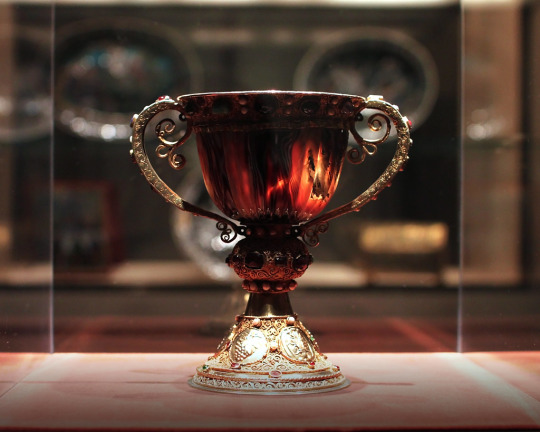
Chalice of Abbot Suger of St. Denis, 1st of 2nd century BC/11th-12th century, National Gallery of Art, Washington

Lorsch Gospels, c. 810

Aachen, Cosmati pavement, similar to the one at Westminster Abbey.

Fra Angelico, Annunciation, 1425-6, Prado, Madrid
Barry describes the marble floor depicted here as marble on a 'primordial plane' a liquid or vapour on the point of solidifying, the 'melting pot of matter in the divine mind before it was separated into created substances'

Giovanni Bellini, Lochis Madonna, c. 1475, Accademia Carrara, Bergamo
My students asked me what my favourite piece of renaissance architecture was. I don't have a favourite, but having been reading Barry's book, I had to pick the church of Maria dei Miracoli (1481-7) which came across unexpectedly on my last visit to Venice. Its a little jewel.


Plan of the marble floor of St Marco, Venice, by Angelo Visentini, 1761, Museo Correra, Venice

Tomb of St Cecilia, Rome, 1599-1603 - she is depicted shining with the light of immortality in pure white Pentelic marble, supposedly in the position she was found in.
0 notes